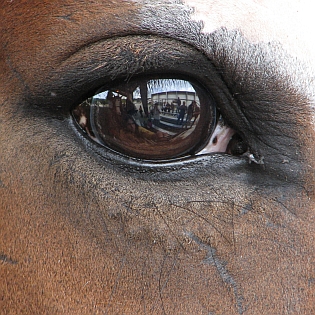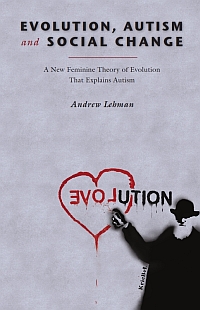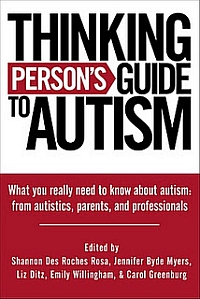Horse-Assisted Therapy and Eye Contact
 In the past couple of months, I’ve begun horse-assisted therapy at Miracles in Motion in Keene, NH. I decided to begin the work after reading about the story of Jaycee Lee Dugard, the California woman who was abducted at the age of 11 and held against her will for 18 years. One of the ways in which she and her family are working to repair trust is through horse-assisted therapy. When I first read about the therapy, I immediately realized that it was something I’d love to do. Between the trauma history of my childhood and my autistic lack of guile, trust has always been a big issue for me. Besides, I love working with farm animals and, since moving off the farm in 2008, I had been missing them a great deal. So I decided to give horse-assisted therapy a try.
In the past couple of months, I’ve begun horse-assisted therapy at Miracles in Motion in Keene, NH. I decided to begin the work after reading about the story of Jaycee Lee Dugard, the California woman who was abducted at the age of 11 and held against her will for 18 years. One of the ways in which she and her family are working to repair trust is through horse-assisted therapy. When I first read about the therapy, I immediately realized that it was something I’d love to do. Between the trauma history of my childhood and my autistic lack of guile, trust has always been a big issue for me. Besides, I love working with farm animals and, since moving off the farm in 2008, I had been missing them a great deal. So I decided to give horse-assisted therapy a try.
Miracles in Motion exists to help children and adults with a range of goals, from trauma-related healing to working with physical, cognitive, and intellectual disabilities. As I’m finding, the therapy isn’t just helping with trust issues; it’s helping with physical balance, sensory integration, and general self-confidence as well. I absolutely love horses, but I have always been terrified of them—care of my mother, who instilled in me the fear that if I got on a horse, it would throw me off and kill me. Needless to say, I’ve overcome that fear. I’m not only able to get on a horse, but I’m also able to ride while stretching my arms in the air and twisting from side to side! If I could go to Miracles in Motion every day, I would.
A few weeks back, I had an interesting conversation with my instructors, Victoria and Frank, about how to make eye contact with horses. Victoria began by telling me that predators tend to have eyes in the front of their faces and that they stare at their prey in a very focused way. Prey animals, however, tend to have eyes on the sides of their faces, allowing for a great deal of peripheral vision that increases their safety. She encouraged me to try and look at the world like a horse by relaxing my focus and having “soft eyes” that could take in all the information in my peripheral vision. She then told me that I have to use soft eyes when looking at a horse, because if you make very focused eye contact with a horse, the horse will think you’re a predator, break eye contact, and try to get away from you. I had already noticed that making direct eye contact with a horse made the horse very uncomfortable, but I hadn’t understood why.
I immediately began to understand my own difficulties with eye contact. In American society, people tend to make eye contact somewhat aggressively. Most people do not use “soft eyes.” As an autist, I walk around the world with a very sensitive system that can feel assaulted by such things as loud music and sudden bursts of noise, nasty words, bullying behavior, deception, harshness, and so on. In other words, in the sensory and emotional world, I am more akin to vulnerable prey than aggressive predator. Even though I advocate for and defend myself in order to stay out of the role of victim, I encounter life with enough native vulnerability that what’s considered “normal” eye contact feels threatening on some level, and I instinctively avoid it. It’s not threatening in the sense that most people are predators and mean me harm; it’s threatening in a more instinctual way, such as when a horse evades eye contact with me even though I personally don’t plan to turn her into glue.
As I was talking with Victoria that day, I realized that I have no trouble making eye contact with her at all, and the more I looked into her eyes, the more I realized how soft they are. Then Frank said, “Look into my eyes and tell me how it feels.” His eyes are very soft, too, and I didn’t have a problem making eye contact with him, either. Victoria and Frank have worked with horses for most of their lives, so their eye contact is different from that of most people I have met.
The only other person with whom I can make consistent, comfortable eye contact and still manage to talk is my husband. He, too, has very soft eyes—not from being around horses, but because he’s such a gentle and non-judgmental person. I have an easier time making eye contact with family and friends than with strangers, probably because I’ve had a long enough experience of trust with them that my instincts aren’t on alert.
Any sense of being fixed by someone’s eyes, however, generally feels aversive, and I avoid it.
Rachel Cohen-Rottenberg’s Horse-Assisted Therapy and Eye Contact first appeared at Journeys with Autism, and is republished here with permission. Rachel’s recently published book is The Uncharted Path: My Journey with Late-Diagnosed Autism.
Rachel Cohen-Rottenberg on 09/9/10 in featured, Society | No Comments | Read More

